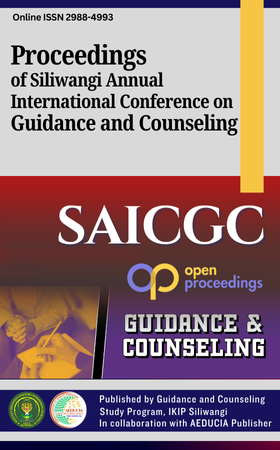Final-Year Students in Terms of Career Maturity and Employability
DOI:
https://doi.org/10.64420/saicgc.v3i1.33Keywords:
Career maturity; Employability, Students\Abstract
After completing their education at university, students will face a world that is much different from campus world. How mature these students are to start their career and their readiness to face the world of work are important things to research. This research was carried out with a quantitative approach to see the connection between these two variables. This research was conducted on 184 final-year students at the UNJANI Faculty of Psychology using Sample Random Sampling techniques. The measurements used are the Career Maturity Inventory-Form C questionnaire proposed by Crites & Savickas (2011) and the Employability questionnaire, which is an adaptation of the measuring tool created by Pool & Sewell (2007). Data processing is JASP 0.14.1.0 for Windows which uses Cronbach's Alpha coefficient, so the reliability test results of the measuring instrument are 0.924 and employability 0.975. The research results show that there is a low positive connection between Career Maturity and Employability (r = 0.147*, p < 0.05), meaning that there is a positive connection between Career Maturity and Employability. However, if the subject has high Career Maturity, it does not necessarily mean that his Employability is high as well. Currently, students with high Career Maturity are at 27.17%, medium ones are at 61.41% and low ones are at 11.41%. As for Employability, 16.4% of students are found to have high Employability, 69% are medium and 14.6% are low.
References
Adelina, Deila. (2018). Hubungan Antara Self-efficacy Dengan Kesiapan Kerja Pada Mahasiswa Tingkat Akhir. Undergraduate (S1) Thesis, University of Muhamadiyah. Malang.
AL Kadiyono, G Gunawan, A Budiarto, E Andriani. (2020). Pelatihan Personal Branding Bagi Persiapan Pengembangan Karir Mahasiswa Tingkat Akhir. International Journal of Community Service Learning. Volume 4 Nomor 4 2020, pp 253-273. http://dx.doi.org/10.23887/ijcsl.v4i4
Alfionita, Wina. (2020). Hubungan antara Self Directed Learning (SDL) dengan Employability Pada Mahasiswa Tingkat Akhir Universitas Jenderal Achmad Yani. Skripsi. Universitas Jendral Achmad Yani. Cimahi
Atpen, Merrysha Eudia (2019) Hubungan antara kecerdasan emosional dengan Employability pada mahasiswa tingkat akhir. Skripsi thesis, Sanata Dharma University. http://repository.usd.ac.id/id/eprint/32892
Baiti, R. D., Abdullah, S. M & Rochwidowati, N. S. (2018), Career Self-Efficacy Dan Kesiapan Kerja Pada Mahasiswa Semester Akhir. Jurnal Psikologi Integratif, 5(2), 128-141. https://doi.org/10.14421/jpsi.2017.%
Budiarto, G Gunawan, AL Kadiyono, E Andriani. (2021). Predicting Graduate Employability through Personal Development Training in Digitalization Context: Association of Industrial & Organizational Psychology (APIO) West Java. Vol 24 J. Legal Ethical & Regul. Isses 1. Print ISSN: 1544-0036; Online ISSN: 1544-0044
Chen, J. and Silverthorne, C. (2008), "The impact of locus of control on job stress, job performance and job satisfaction in Taiwan", Leadership & Organization Development Journal, Vol. 29 No. 7, pp. 572-582. https://doi.org/10.1108/01437730810906326
Coetzee, M. (2012). A framework for developing student graduateness and employability in the economic and management sciences at the University of South Africa. In M. Coetzee, J. Botha, N. Eccles, H. Nienaber, & N. Holtzhausen (Eds.), Developing student graduateness and employability: Issues, provocations, theory and practical guidelines (pp. 119–152). Randburg: Knowres.
Crites, J. O. (1973). Career Maturity. National Council on Measurement in Education, 4(2), 1-9.
Crites, J.O. and Savickas, M.L. (1996) Revision of the Career Maturity Inventory. Journal of Career Assessment, 4, 131-138. https://doi.org/10.1177/106907279600400202
Dacre Pool, L. and Sewell, P. (2007), “The key to employability: developing a practical model of graduate employability”, Education & Training, Vol. 49 No. 4, pp. 277-289. http://dx.doi.org/10.1108/00400910710754435
Dacre Pool, L., Qualter, P., & Sewell, P. (2014). Exploring the factor structure of the CareerEDGE Employability Development Profile. Education and Training, 56(4), 303-313. https://doi.org/10.1108/ET-01-2013-000
de Grip, A., van Loo, J. B., & Sanders, J. M. A. F. (2004). The Industry Employability Index: Taking account of supply and demand characteristics. International Labour Review, 143(3), 211-233. https://doi.org/10.1111/j.1564-913X.2004.tb00269.x
Deloitte . (2019) Generasi Milenial dalam Industri 4.0: Berkah Bagi Sumber Daya Manusia Indonesia atau Ancaman. PT. Deloitte Konsultan Indonesia and KJPP. https://www2.deloitte.com/content/dam/Deloitte/id/Documents/about-deloitte/id-about-dip-edition-1-chapter-2-id-sep2019.pdf
Jatmika, D. & Linda. (2015). Gambaran Kematangan Karir Pada Mahasiswa Tingkat Akhir. Jurnal Psibernerika. Vol. 8. No. 2. http://dx.doi.org/10.30813/psibernetika.v8i2.497
Johnny, J. O., & Yanuvianti, M. (2019). Studi Deskriptif Mengenai Kematangan Karir Pada Mahasiswa Di Universitas Islam Bandung. Prosiding Psikologi, 5(1), 45–51. http://103.78.195.33/handle/123456789/21264
Kadiyono, A. L., & Sulistiobudi, R. A. (2018). Peningkatan graduate employability melalui career development training pada mahasiswa. Jurnal Pengabdian Kepada Masyarakat, 46(3), 72.
Kim, Hee Jeong. (2020). The Effects of Economic Stress, Career Maturity and Major Satisfaction on the Job Stress in Third and Fourth Grade Students of University. Medico Legal Update, 20(1), 1558-1563. https://doi.org/10.37506/mlu.v20i1.597
Lestari, Edo and Tentama, Fatwa (2020) Students Career Maturity scale: Construct validity and reliability study. International Journal of Scientific and Technology Research, 8 (01). pp. 480-485. http://eprints.uad.ac.id/id/eprint/20087
Listyowati, A., Andayani, T.R., & Karyanta, N.A. (2012). Hubungan antara kebutuhan aktualisasi diri dan dukungan sosial dengan kematangan karier pada siswa kelas XII SMA N 2 Klaten. Jurnal Wacana, 4(8), 116-145. https://doi.org/10.13057/wacana.v4i2.23
Ningrum, D. S. A., & Pratiwi, E. A. (2021). GAMBARAN EMPLOYABILITY PADA MAHASISWA TINGKAT AKHIR UNIVERSITAS JENDERAL ACHMAD YANI (UNJANI). Quanta : Jurnal Kajian Bimbingan Dan Konseling Dalam Pendidikan, 5(3), 106–110. https://doi.org/10.22460/q.v5i3p106-110.2816
Savickas, M.L. and Porfeli, E. (2011). Revision of the Career Maturity Inventory: The Adaptability Form. https://www.researchgate.net/publication/254110877_Revision_of_the_Career_Maturity_Inventory_The_Adaptability_Form
TE Ratnasari (2019). Pengaruh Career Calling terhadap Employability pada Mahasiswa. Tingkat Akhir Fakultas Psikologi UNJANI. Skripsi. Universitas Jendral Achmad Yani. Cimahi
Downloads
Published
How to Cite
Issue
Section
License
Copyright (c) 2025 Endah Andriani Pratiwi, Melynda Fatwa

This work is licensed under a Creative Commons Attribution-ShareAlike 4.0 International License.
Authors who publish with this journal agree to the following terms: (1) Authors retain copyright and grant the journal right of first publication with the work simultaneously licensed under a Creative Commons Attribution-ShareAlike 4.0 International. that allows others to share the work with an acknowledgement of the work's authorship and initial publication in this journal; (2) Authors are able to enter into separate, additional contractual arrangements for the non-exclusive distribution of the journal's published version of the work (e.g., post it to an institutional repository or publish it in a book), with an acknowledgement of its initial publication in this journal; (3) Authors are permitted and encouraged to post their work online (e.g., in institutional repositories or on their website) prior to and during the submission process, as it can lead to productive exchanges, as well as earlier and greater citation of published work.




















